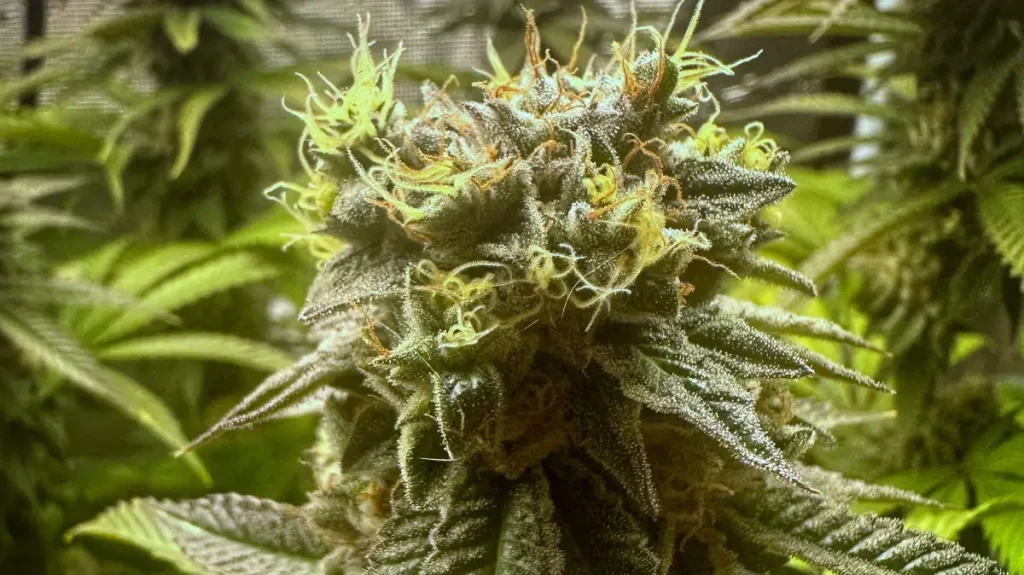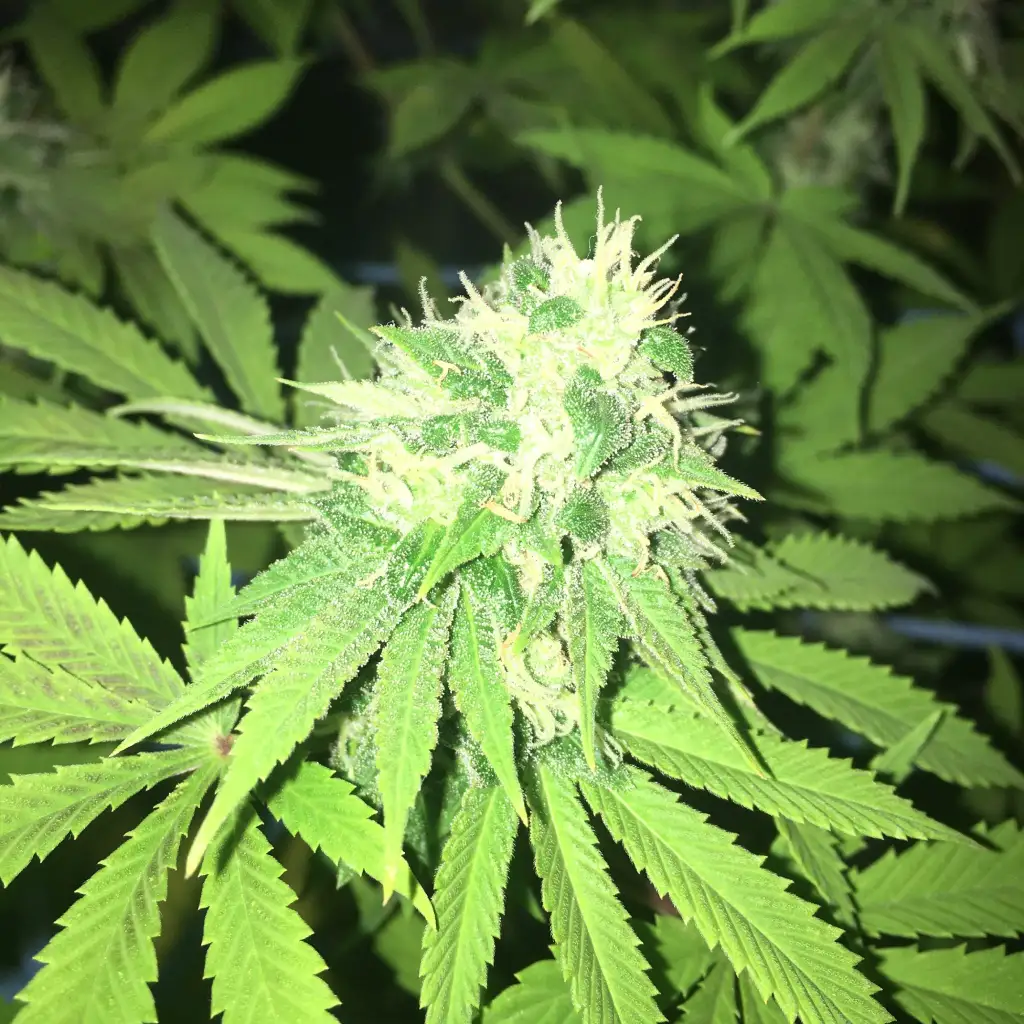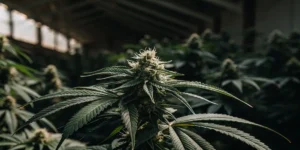Big Tooth Strain Description
Big Tooth Strain is a unique hybrid cannabis strain with Afghan, Hawaiian, and Nepalese genetics. Its dense, resin-coated buds exude a spicy, herbal aroma with subtle floral undertones. This strain grows quickly and produces abundant resin, making it a top choice for growers. Its effects combine mental stimulation with physical relaxation, making it versatile for various uses. Recreational users enjoy its uplifting buzz, while medicinal consumers turn to it for stress and pain relief.
The earthy, woody aroma of Big Tooth Strain, combined with its potent effects, has cemented its popularity. Its well-balanced indica-sativa traits make it ideal for daytime focus or evening relaxation. Growers value its adaptability and resilience.
Environmental Requirements for Growing Big Tooth Strain
Big Tooth Strain thrives in moderate to warm climates, performing best in Mediterranean-like conditions. It adapts well to indoor and outdoor cultivation but achieves maximum yields outdoors under full sunlight. Proper humidity control during flowering is vital to prevent mold on its dense buds. The ideal temperature range is 20-26°C (68-79°F), with balanced soil pH and good air circulation.
Outdoors, this strain’s robust growth benefits from healthy soil and natural compost. Indoors, controlled lighting and ventilation help mimic optimal conditions. Careful attention to temperature and humidity levels ensures consistent growth and exceptional harvests.
Setting Up the Growing Cannabis Space
Indoor Cannabis Cultivation
Indoor cultivation of Big Tooth Strain benefits from hydroponics or soil with added perlite for aeration. LED or HPS lights should provide 18 hours of light during the vegetative phase. Training techniques like topping and low-stress training (LST) can optimize plant structure and yield. Maintaining 50-60% humidity during the vegetative stage, reduced to 40-50% during flowering, ensures healthy development.
Indoor setups require ventilation to manage humidity and temperature. Proper spacing between plants and airflow around the canopy prevents mold and promotes even growth. Regular monitoring of conditions supports optimal outcomes.
Outdoor Cannabis Cultivation
Outdoors, Big Tooth Strain grows into a substantial bush with sturdy branches. Planting in early spring in well-prepared soil with organic compost maximizes vegetative growth. Large pots or direct ground planting allow roots to spread, enhancing yield. Companion plants like marigolds naturally deter pests and enrich soil.
Ensuring full sunlight and protecting plants from extreme weather are crucial for success. Regular inspections for pests and proper watering schedules help maintain robust plants that deliver high-quality harvests.
Propagation and Germination of Big Tooth Strain
Big Tooth Strain seeds germinate reliably in warm, humid conditions. The paper towel method is widely used, requiring consistent temperatures of 22-25°C (72-77°F). Seeds sprout within 3-5 days and can then be transplanted into small pots with aerated soil.
Using a root enhancer during germination strengthens root systems, promoting vigorous growth. Proper care during these initial stages sets the foundation for healthy plants and bountiful harvests.
Vegetative Phase of Big Tooth Strain
In the vegetative phase, Big Tooth Strain displays rapid, bushy growth. Its broad leaves require ample nitrogen for robust development. Training methods like topping or LST encourage lateral branching and optimize canopy light distribution. Ideal conditions include temperatures between 20-26°C (68-79°F) and 50-60% relative humidity.
Regular watering without over-saturation is essential. Monitoring nutrient levels and avoiding deficiencies ensures plants build strong structures to support flowering.
Flowering Phase of Big Tooth Strain
Big Tooth Strain’s flowering period lasts 8-9 weeks, producing dense, resinous buds with earthy, spicy aromas. During this phase, phosphorus and potassium levels should be increased, while nitrogen is minimized. Temperatures should be reduced to 18-24°C (64-75°F), and humidity kept below 50%.
Proper airflow and light penetration prevent mold and enhance trichome production. Adjusting feeding schedules and environmental conditions ensures peak resin and terpene development.
Cannabis Fertilization and Nutrition – Big Tooth Strain
Big Tooth Strain responds well to organic fertilizers, thriving on nitrogen during vegetative growth and phosphorus/potassium during flowering. Micronutrients like calcium and magnesium are vital throughout the cycle. Maintaining a soil pH of 6.0-6.5 optimizes nutrient absorption, preventing deficiencies.
Balanced feeding schedules, along with periodic soil testing, support consistent growth. Avoid overfeeding to prevent nutrient burn, which can affect bud quality.
Pest and Disease Control for Cannabis Growing
Prevention
Regular inspections and maintaining a clean growing environment are essential to minimizing pest risks when cultivating Big Tooth Strain. Checking plants daily for signs of pests like aphids, spider mites, or whiteflies ensures early detection and intervention. Neem oil, insecticidal soaps, or essential oil sprays are effective chemical-free options to deter infestations. Introducing companion plants such as marigold or lavender enhances pest prevention by naturally repelling harmful insects while promoting a balanced ecosystem. A clean workspace with sanitized tools also reduces the risk of introducing pathogens.
Preventive measures should also include maintaining optimal humidity and airflow, as poor environmental conditions can encourage fungal growth. Keep foliage dry and avoid overwatering, which can attract pests like fungus gnats. Consistent monitoring and adopting these proactive strategies will create a resilient growing space, reducing the likelihood of pest or disease outbreaks.
Corrective Actions
If pests or diseases are detected on Big Tooth Strain plants, swift action is crucial to prevent spread. Begin by isolating the affected plants to protect the healthy ones. Use organic insecticides for pests such as aphids, spider mites, or thrips, and apply them according to the product guidelines for maximum effectiveness. For fungal issues like powdery mildew or mold, fungicides specifically labeled safe for cannabis plants are essential. Combining treatments with improved airflow and reduced humidity will further inhibit fungal growth.
Pruning infected leaves and disposing of them away from the grow space minimizes contamination risks. Regularly sterilize tools used during this process to avoid transferring pathogens. For severe infestations, introducing beneficial insects like ladybugs or predatory mites can naturally control pest populations. These corrective measures, combined with enhanced environmental controls, ensure the health of your plants and the success of your harvest.
Harvesting and Curing for Cannabis Growing
Big Tooth Strain typically reaches peak harvest time in late September to early October when grown outdoors. To determine readiness, examine the trichomes closely using a magnifying glass. They should appear milky white with a few amber hues, signaling the ideal time to harvest. Harvesting at this stage ensures maximum potency and optimal flavor. Carefully cut the branches and handle them gently to preserve the trichomes.
After harvest, buds should dry in a dark, well-ventilated space at around 20°C (68°F) with a relative humidity of 50%. This environment prevents mold and preserves terpene profiles. Once dried, curing the buds in glass jars for 2-3 weeks enhances their flavor, aroma, and potency. Opening the jars daily during the first week allows excess moisture to escape, preventing mold. A thorough curing process ensures that Big Tooth Strain reaches its full potential, offering a smooth smoking or vaping experience.
Is Big Tooth Strain Indica or Sativa?
Big Tooth Strain is a hybrid that balances indica and sativa traits, leaning slightly towards the indica side. Its genetic makeup provides a unique combination of effects, making it a versatile choice for growers and consumers alike. With the uplifting cerebral stimulation associated with sativa strains, it delivers a sense of focus and creativity that’s ideal for daytime use or social settings.
At the same time, the relaxing physical effects from its indica lineage help ease tension and stress. This balance makes Big Tooth Strain suitable for diverse uses, from enhancing productivity during the day to unwinding in the evening. Its adaptability to different scenarios has made it a favorite among both recreational and medicinal users.
Advantages of Growing Big Tooth Strain
Big Tooth Strain stands out for its quick growth and impressive resin production, making it a desirable choice for cultivators of all skill levels. Its strong resistance to pests and mold enhances its reliability, while its high resin output makes it a great candidate for concentrate production. The strain thrives in a variety of environments, whether indoors or outdoors, offering flexibility to growers in different climates and conditions.
Its adaptability extends to soil and hydroponic systems, and it responds well to training techniques that maximize yield. With consistent care, growers can achieve robust harvests featuring dense, aromatic buds that are highly marketable. Big Tooth Strain’s low-maintenance nature, combined with its high productivity, makes it a rewarding option for any grower.
Disadvantages of Growing Big Tooth Strain
One challenge of growing Big Tooth Strain is its susceptibility to mold, particularly in humid conditions. The density of its buds makes proper airflow and humidity control crucial during the flowering phase. Without these precautions, growers risk losing part of their harvest to mold or mildew. Implementing dehumidifiers and proper spacing between plants can mitigate this issue.
Another consideration is its strong aroma, which, while appealing to many, may require carbon filters in indoor setups for discretion. These factors necessitate additional attention and equipment, but with proper management, they do not detract from the overall benefits of growing this versatile strain.

Week-by-Week Growth Plan
Week 1-2 (Germination)
Place Big Tooth Strain seeds in a warm, humid environment using the paper towel method or directly in soil. Maintain temperatures between 22-25°C (72-77°F) to encourage sprouting. Ensure consistent moisture levels, but avoid oversaturation, which can hinder germination. Seeds typically sprout within 3-5 days and should be handled with care when transferring to their first pots.
Week 3-4 (Early Vegetative)
Transplant seedlings into larger pots with well-aerated soil. Begin an 18/6 light cycle using LED or HPS lights and feed with mild nitrogen-rich nutrients. Maintain humidity at 50-60% for optimal growth. During this stage, the plants will develop stronger roots and initial foliage. Ensure proper watering practices to avoid overwatering or nutrient lockout.
Week 5-6 (Vegetative Growth)
Increase nutrient strength gradually, focusing on nitrogen to support robust leaf and stem development. Apply low-stress training (LST) to shape plant structure and improve light penetration. Temperatures should remain between 20-26°C (68-79°F) with adequate airflow to prevent humidity build-up. Plants will exhibit vigorous growth during this phase, setting the stage for flowering.
Week 7-8 (Late Vegetative)
Continue with training techniques like topping and ensure nutrient levels are balanced to avoid deficiencies. Inspect plants for strong stems and healthy foliage in preparation for flowering. Maintain consistent watering, ensuring soil doesn’t become waterlogged. This phase is critical for setting up a solid foundation for optimal bud production.
Week 9-12 (Early Flowering)
Switch to a 12/12 light cycle to initiate flowering. Gradually reduce humidity to 40-50% and increase feeds rich in phosphorus and potassium to promote bud development. Watch for pre-flowers and ensure even light distribution. This phase marks the beginning of visible flower formation, requiring precise care to maximize resin and terpene production.
Week 13-14 (Mid Flowering)
Monitor bud development closely as trichomes begin to form. Adjust temperatures to 18-24°C (64-75°F) to enhance resin production. Use a trellis or plant supports to prevent branches from bending under the weight of developing buds. This stage is crucial for shaping the final quality of the harvest.
Week 15-16 (Late Flowering)
Flush plants with pure water during the last two weeks to remove excess nutrients. Keep humidity below 40% to prevent mold. Monitor trichomes, which should transition to a milky appearance with some amber hues. Plants are near their peak potency and flavor at this point, requiring careful attention.
Week 17 (Harvest)
Harvest Big Tooth Strain when trichomes are predominantly milky with amber accents, signaling peak potency. Dry buds in a dark, ventilated space at 20°C (68°F) and 50% humidity. Curing for 2-3 weeks in airtight jars enhances aroma, flavor, and potency, ensuring a top-tier final product.
FAQs about Big Tooth Strain
What is the THC percentage of Big Tooth Strain?
Big Tooth Strain generally has a THC content of 18-22%, providing a potent experience suitable for both recreational and medicinal users. It offers a balance of euphoria and relaxation.
How long does it take for Big Tooth Strain to flower?
Big Tooth Strain has a flowering period of 8-9 weeks, making it a relatively fast hybrid. This allows growers to achieve impressive results within a shorter growth cycle.
What flavors and terpenes are present in Big Tooth Strain?
This strain features earthy, spicy, and woody flavors. Its terpene profile includes myrcene for relaxation, caryophyllene for anti-inflammatory effects, and limonene for a citrusy uplift.
Can Big Tooth Strain be grown both indoors and outdoors?
Yes, Big Tooth Strain is highly adaptable and thrives in indoor setups with controlled conditions or outdoor environments with adequate sunlight. Its resilience suits diverse climates and methods.
What are the medicinal benefits of Big Tooth Strain?
Big Tooth Strain helps alleviate stress, anxiety, mild pain, and insomnia. Its balanced effects provide both mental clarity and physical relaxation, making it versatile for various conditions.





